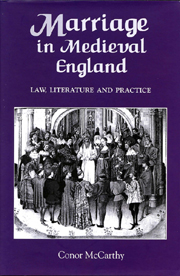4 - Love and Marriage
Published online by Cambridge University Press: 12 September 2012
Summary
C. S. Lewis and marital love
In his 1936 book, The Allegory of Love, C. S. Lewis argued that a new form of love had found expression in the French troubadour poetry of the central Middle Ages, and that this new form of love exercised a fundamental influence on the literature of the later medieval period, in France, but also in England. He argued further that this new form of love with which medieval literature was concerned had nothing to do with marriage, and was in fact an idealization of adultery. For Lewis, marriage from the medieval aristocracy's viewpoint had nothing to do with sentiment, and everything to do with the ideology of marriage as alliance discussed in the previous chapter. He also argued that the medieval Church's theory of marriage excluded any possibility of love being important in the making of medieval marriages. If we consider Georges Duby's notion of two models of marriage, one aristocratic and one ecclesiastical, existing in France in the central Middle Ages, it will be clear that, for Lewis, the marriage ideologies of both groups are seen as hostile to the idea of love as something compatible with marriage:
Marriages had nothing to do with love, and no ‘nonsense’ about marriage was tolerated. All matches were matches of interest, and, worse still, of an interest which was continually changing.When the alliance which had answered would answer no longer, the husband’s object was to get rid of the lady as quickly as possible. Marriages were frequently dissolved. The same woman who was the lady and ‘the dearest dread’ of her vassals was often little better than a piece of property to her husband. He was master in his own house. ...
- Type
- Chapter
- Information
- Marriage in Medieval EnglandLaw, Literature and Practice, pp. 92 - 106Publisher: Boydell & BrewerPrint publication year: 2004



